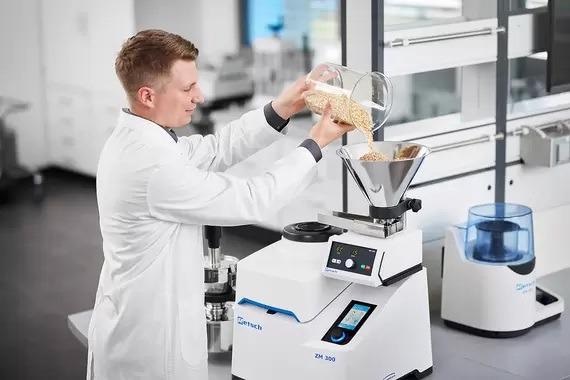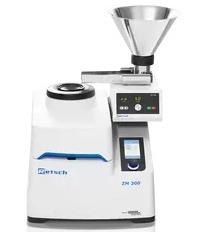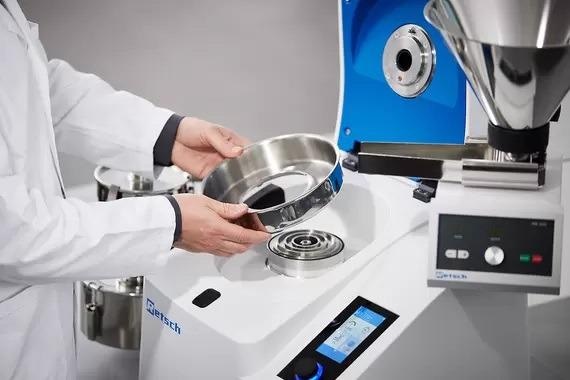Rotor mills are used to reduce the size of soft to medium-hard materials as well as temperature-sensitive or fibrous materials at high speeds.
The Ultra Centrifugal Mill ZM 300 delivers the utmost grinding performance while being simple to operate. The variable speed from 6,000 to 23,000 rpm allows for gentle, neutral-to-analysis sample preparation in a short period of time.
Even for prolonged grinding procedures or the pulverization of huge sample quantities, consistency is ensured thanks to an integrated temperature monitoring system.
The ZM 300 is an all-rounder with a wide range of rotors, ring sieves and cassettes to fulfill the needs of a wide range of size reduction operations.
Ultra Centrifugal Mill ZM 300 - Introduction #RETSCH #rotormill #laboratoryinstruments
Video Credit: Verder Scientific GmbH & Co. KG.
The Standard for Food & Feed
- A patented cassette design ensures optimal sample recovery while being simple to clean.
- A wide speed range of 6,000 to 23,000 rpm.
- Pre- and fine grinding in one working run result in gentle high-speed pulverization.
- Sample collection vessels with capacities ranging from 250 ml to 4.5 l.
- Monitoring of the cassette temperature allows for optimal process control and reproducibility.
- Various cyclone systems and an automated vibratory feeder are offered.
- Ring sieves with aperture sizes ranging from 0.08 to 10 mm provide a defined end fineness.
- Optional cassette for up to 600 ml of sample volume.

Image Credit: Verder Scientific GmbH & Co. KG.
Increased Reproducibility Through Temperature Monitoring
By keeping the grinding duration as short as possible and the temperature increase as minimal as possible, the speed range of 6000 to 23000 rpm allows for optimal customization of the grinding process to the sample requirements.
Too much heat can negatively affect the grinding results, for instance, if moisture or volatile components escape.
The temperature of the cassette lid near the ring sieve is measured by an inbuilt temperature sensor on the ZM 300. The mill’s display constantly displays the recorded temperature, allowing the operator to fine-tune the grinding process and increase reproducibility.

Image Credit: Verder Scientific GmbH & Co. KG.
Cryogenic Grinding
Cryogenic or cold grinding is an excellent method for crushing substances that cannot be finely ground at normal temperatures.
This process comprises chilling the sample material with grinding aids like liquid nitrogen (-196 °C, embrittlement outside the mill) or dry ice (-78 °C, sample/dry ice mixture) to embrittle it and improve the breaking behavior.
Furthermore, cooling helps to maintain highly volatile components in the sample. The ZM 300 makes cryogenic grinding simple, and it is especially useful for plastics or other temperature-sensitive samples.
The process is demonstrated in the video below using the predecessor model ZM 200, which is the same as in the ZM 300.
Ultra Centrifugal Mill ZM 200 - Application with Dry Ice #RETSCH #rotormill #laboratoryinstruments
This video shows dry ice grinding of plastic granules with the ZM 200 which also applies to the ZM 300. Video Credit: Verder Scientific GmbH & Co. KG.
Convenient Operation and Easy Cleaning
The ZM 300 is simple and safe to use. The touch display with a rotary knob makes entering grinding parameters simple. It displays the current cassette temperature and loads during grinding, which helps to avoid overloads caused by feeding the sample too quickly.
The patented cassette principle and a push-fit method eliminate the need for tools for insertion and removal.
Thus, cleaning rotors and ring sieves becomes extremely simple. All parts that come into contact with the sample can be washed in the dishwasher or under running water.

Image Credit: Verder Scientific GmbH & Co. KG.